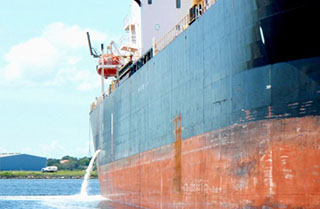Prototypical systems for treating ballast water with ultraviolet light will be judged on their ability to kill tiny marine organisms outright, not on how they limit the ability to grow and reproduce, the Coast Guard’s Marine Safety Center announced this week.
The MSC informed four ultraviolet equipment manufacturers that one alternative method for testing the efficacy of ballast water treatment, called the Most Probable Number or MPN, will not be considered equivalent by the Coast Guard.
Ultraviolet radiation is used in a number of disinfection applications. One analogy for ballast water is shellfish depuration, where clams harvested from waters with bacteria are held in on onshore facility for 48 hours while being flushed with water treated with ultraviolet.
Options for treating and cleaning ballast tanks were the subject of one panel session at the International WorkBoat Show in early December, where the pending Coast Guard decision on MPN testing came up.
In a Dec. 14 post to Maritime Commons, a Coast Guard blog, the safety center told why it was making the changes.
“The regulations specifically require ballast water treatment systems to be evaluated based on their ability to kill certain organisms. Since the proposed MPN method assesses the viability of an organism to colonize after treatment, it measures to a different standard than that required by the regulations.”
The language is confusing, but more simply put the Coast Guard prefers to measure a maximum allowable number of living organisms per volume measure of water.
Writing in Maritime Commons Dec. 7, Rear Adm. Paul Thomas, the assistant commandant for prevention policy, explained the Coast Guard’s reasoning: “Theoretically, one would assess viability by culturing each of the unique organisms found in a sample of ballast water to determine if they can reproduce after treatment. This raises several technical challenges, the most important being that it may not be possible to culture all of the types of organisms found in ballast water; simply put, we do not yet know how to consistently induce them to reproduce in the laboratory.
“In addition many organisms cannot be induced to reproduce under laboratory conditions but may be able to reproduce in natural environments. Finally, it is not clear that organisms rendered nonviable will remain so over time. It has been shown that some organisms have repair mechanisms that can undo damage caused by ultra-violet radiation and thus restore the ability to reproduce.”
The Coast Guard is continuing to evaluate ballast water management system, or BWMS, that use ultraviolet, and the manufacturers affected by the recent ruling can still appeal it.





